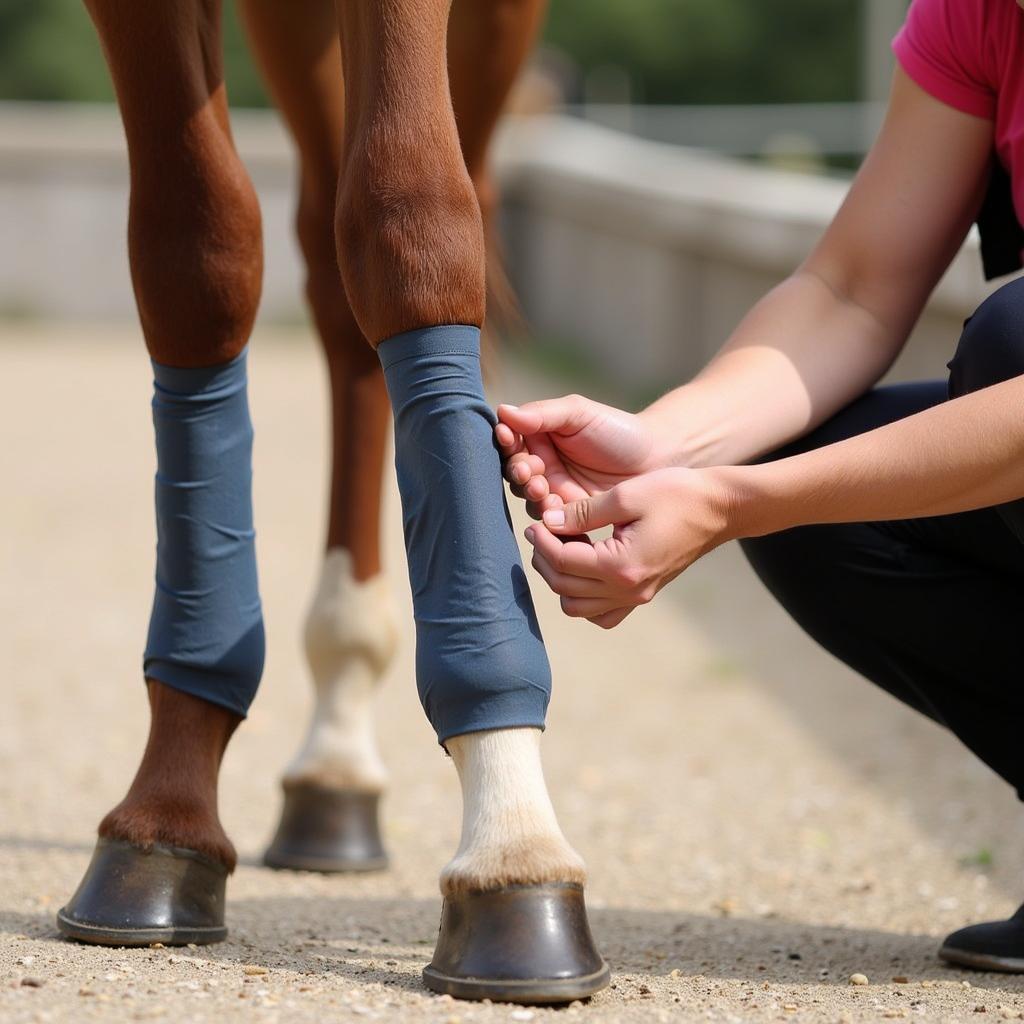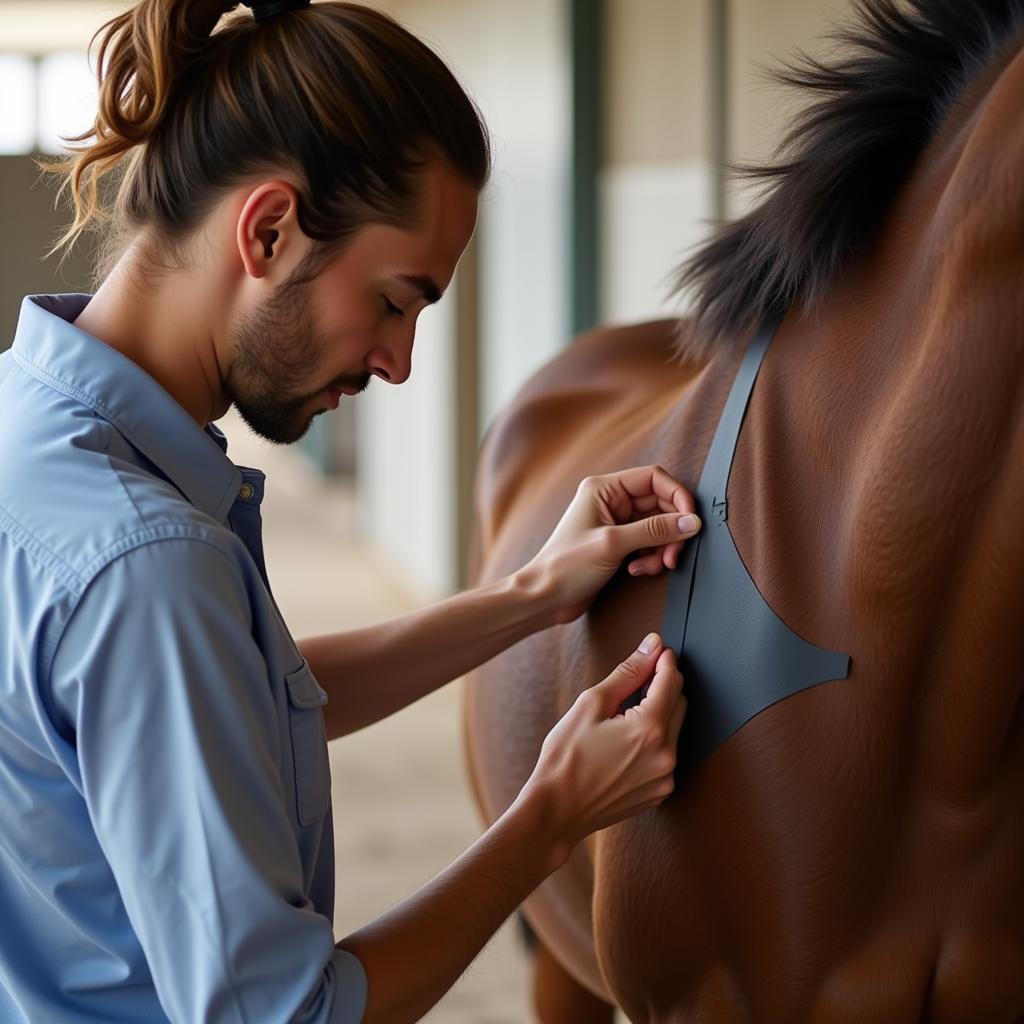Kinesio tape has become increasingly popular in recent years, not only for human athletes but also for horses. But what exactly is kinesio tape, and how can it benefit your equine companion?
 Kinesio tape applied to a horse's leg
Kinesio tape applied to a horse's leg
Understanding Kinesio Tape and Its Benefits
Kinesio tape is a special kind of elastic therapeutic tape that is applied to the skin. Unlike traditional athletic tape, which is designed to restrict movement, kinesio tape is designed to support and improve the body’s natural healing process while allowing for a full range of motion. It is latex-free, breathable, and can be worn for several days at a time.
For horses, kinesio tape can provide a variety of benefits, including:
- Pain Relief: By lifting the skin and reducing pressure on underlying tissues, kinesio tape can help to alleviate pain associated with muscle soreness, inflammation, and injuries.
- Improved Circulation: The lifting effect of the tape can also improve blood flow and lymphatic drainage, which can help to reduce swelling and promote healing.
- Enhanced Muscle Function: Kinesio tape can help to support and stabilize muscles without restricting movement, allowing horses to maintain their natural range of motion and improve muscle performance.
- Reduced Inflammation: By improving circulation and lymphatic drainage, kinesio taping can contribute to reduced inflammation in injured or strained areas.
- Support for Joints and Ligaments: The tape’s elasticity can provide gentle support to joints and ligaments, aiding in stability and potentially reducing the risk of further injury.
How Does Kinesio Tape Work?
While the exact mechanisms by which kinesio tape works are still being studied, it is believed to achieve its effects through a combination of factors:
- Sensory Stimulation: The tape’s elasticity provides gentle stimulation to the skin’s sensory receptors, which can help to reduce pain perception and improve muscle activation.
- Decompression and Lymphatic Drainage: By lifting the skin, kinesio tape creates a space between the skin and underlying tissues, reducing pressure and promoting the flow of lymphatic fluid, which helps to clear toxins and reduce swelling.
- Improved Proprioception: The tape’s constant feedback to the skin’s sensory receptors can enhance the horse’s awareness of its body position and movement, improving balance and coordination.
 An equine therapist carefully applies kinesio tape to a horse
An equine therapist carefully applies kinesio tape to a horse
When to Consider Kinesio Tape for Your Horse
Kinesio taping can be a valuable tool for addressing a range of equine conditions, including:
- Muscle Soreness and Stiffness: Help your horse recover faster from strenuous workouts or competitions by reducing muscle soreness and improving flexibility.
- Back Pain: Support back muscles and improve posture in horses experiencing back pain or discomfort.
- Ligament and Tendon Injuries: Provide support and stability to injured ligaments and tendons during the healing process.
- Swelling and Inflammation: Reduce swelling and inflammation associated with injuries or overuse.
- Scar Tissue Management: Improve the flexibility and mobility of scar tissue after injuries.
Is Kinesio Taping Right for Your Horse?
While kinesio tape can be a valuable tool, it’s essential to consult with your veterinarian or a qualified equine therapist to determine if it’s the right treatment option for your horse’s specific needs.
Expert Insight:
“Kinesio taping should always be applied by a trained professional who understands equine anatomy and the proper taping techniques,” advises Dr. Emily Carter, DVM, Certified Equine Rehabilitation Therapist. “Incorrect application can be ineffective and may even worsen a condition.”
Finding a Qualified Practitioner
When seeking a practitioner for equine kinesio taping, consider the following:
- Certification: Look for certifications like the Certified Canine and Equine Kinesio Taping Practitioner (CCECKT).
- Experience: Choose a practitioner with experience in taping horses, specifically for your horse’s condition.
- References: Ask for references from other horse owners who have used their services.
Conclusion
Kinesio taping can be a valuable tool in your horse’s overall health and well-being. From pain management to performance enhancement, this innovative therapy can support your equine partner on their journey to optimal health. Remember to consult with a qualified practitioner to determine if kinesio taping is right for your horse and to ensure proper application for the best possible outcome.
If you’re interested in exploring the potential benefits of kinesio taping for your horse, contact us at Justus Horses USA. Our team of experts can answer your questions and help you find a qualified practitioner in your area.
Need Help?
Contact us at:
Phone Number: 0772127271
Email: [email protected]
Address: QGM2+WX2, Vị Trung, Vị Thuỷ, Hậu Giang, Việt Nam.
Our dedicated customer support team is available 24/7 to assist you.